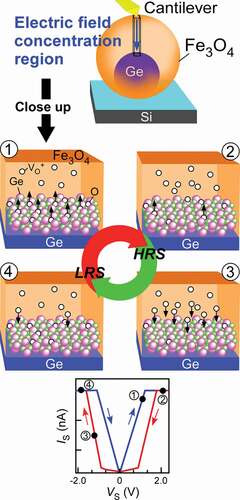ABSTRACT
For realization of new informative systems, the memristor working like synapse has drawn much attention. We developed isolated high-density Fe3O4 nanocrystals on Ge nuclei/Si with uniform and high resistive switching performance using low-temperature growth. The Fe3O4 nanocrystals on Ge nuclei had a well-controlled interface (Fe3O4/GeOx/Ge) composed of high-crystallinity Fe3O4 and high-quality GeOx layers. The nanocrystals showed uniform resistive switching characteristics (high switching probability of ~90%) and relatively high Off/On resistance ratio (~58). The high-quality interface enables electric field application to Fe3O4 and GeOx near the interface, which leads to effective positively charged oxygen vacancy movement, resulting in high-performance resistive switching. Furthermore, we successfully observed memory effect in nanocrystals with well-controlled interface. The experimental confirmation of the memory effect existence even in ultrasmall nanocrystals is significant for realizing non-volatile nanocrystal memory leading to neuromorphic devices.
Graphical abstract

CLASSIFICATION:
1. Introduction
New informative systems toward next-generation human society such as artificial intelligence and internet of things have been extensively studied. Now, the systems for huge, fast, and complex calculations are requiring neuromorphic devices [Citation1]. A lot of researchers have enthusiastically paid attention to memristor working like synapse: i.e. memorizing an electric current history [Citation2,Citation3]. Resistance random access memory (ReRAM), which can realize memristor, has great advantages such as high-speed response, low power consumption, and good scalability [Citation4–Citation10].
The resistive switching characteristics were mainly observed in oxide-based materials such as TaOx [Citation11], TiOx [Citation12,Citation13], and so on [Citation14–Citation16]. Fe3O4 with a higher Clark number (Fe is rank 4th) is a more industrially compatible material in terms of element abundance, low material cost, and non-toxicity [Citation17,Citation18]. Polycrystalline Fe3O4 film showed resistive switching characteristics based on ionic movement [Citation19,Citation20]. However, the Off/On resistance ratio (Off/On ratio) is low (~10) because the leakage current passing through the grain boundaries may degrade the Off resistance. Therefore, forming high-quality Fe3O4 is a key for increasing Off/On ratio.
Nanostructuring approach can be one of the ways to form high-crystallinity materials. We have developed single-crystalline spherical nanocrystals (NCs), where there are almost no defects due to the elastic relaxation of the lattice mismatch strain between NCs and substrates [Citation21]. Hence, the NCs without current leak paths likely show higher Off resistance, leading to higher Off/On ratio. Recently, we have developed core/shell epitaxial Fe3O4/Ge NCs by combining oblique deposition at high temperature with ultrathin SiO2 technique [Citation22–Citation25] (left image in )), where Ge oxides (GeOx) were formed at the Fe3O4/Ge interface by exposure to oxygen atmosphere after epitaxial growth of Fe3O4 (at the final stage of Fe3O4 growth or when exposing to air). Its detail is described in our previous study [Citation17]. The Fe3O4/Ge NCs exhibited high Off/On ratio of ~100 [Citation26], but had large positional variability. To control the resistive switching characteristics well, understanding the mechanism is strongly required. So far, it has been revealed that the resistive switching is originated from the thickness change of high resistance layer (HRL) near Fe3O4/GeOx/Ge interface caused by electric-field-induced oxygen vacancy movement ()). However, the identity of HRL, a key of this nanoionics-based resistive switching, has not been clarified: in the interface layer, existence or non-existence of Fe-Ge mixing, and oxidation degree, etc. The mechanism unclearness related to poor resistive switching performance is ascribed to the unclear and uncontrolled Fe3O4/GeOx/Ge interface.
Figure 1. (a) Schematic diagram of isolated Fe3O4/GeOx/Ge NC memory (left image). The formation of high-crystallinity Fe3O4 and high-purity GeOx at the interface between Fe3O4 and Ge (right image) aiming at high resistive switching performance. (b) Resistive switching mechanism in Fe3O4/GeOx/Ge NCs that have some unclearness: high resistance layer (HRL) which is a key for nanoionics-based resistive switching
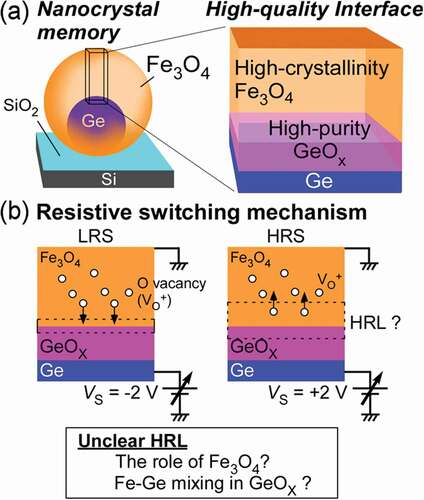
In this study, aiming at forming well-controlled Fe3O4/GeOx/Ge interface in the NC system, we perform low-temperature growth of epitaxial Fe3O4 NCs without the interface reaction degrading the performance by depositing Fe on Ge nuclei at room temperature (RT) under a low-pressure oxygen atmosphere and subsequently post-annealing. Then, we obtain Fe3O4/GeOx/Ge NCs, where Fe3O4 is highly crystalline and the high-quality GeOx is formed between Fe3O4 and Ge. The post-annealed NCs showed uniform resistive switching characteristics (higher switching probability of ~90%) and higher Off/On ratio of ~58. It is found that HRL related to resistive switching mechanism is composed of Fe3O4 near the interface and GeO. Furthermore, we successfully observe the memory effect in the NCs with well-controlled interface. The experimental confirmation of the memory effect existence even in ultrasmall NCs is significant for realizing non-volatile NC memory leading to neuromorphic device.
2. Experimental details
Fe3O4 NCs on Ge nuclei were formed on Si substrates in the chamber equipped with Knudsen cell for Ge and an electron beam evaporator for Fe in the following way. As-doped Si(111) substrates with dimensions of 2 mm×7 mm×0.3 mm were introduced into ultrahigh vacuum chamber at a base pressure of 1 × 10−8 Pa. After degassing the substrates at 500°C for 6 h, Si(111) clean surfaces were obtained by flashing at 1250°C. The ultrathin SiO2 films with the thickness of 0.3 nm were formed on Si(111) substrates by oxidizing the Si surfaces at 600°C for 10 min under an oxygen pressure of 2 × 10−4 Pa [Citation17,Citation21–Citation26]. Epitaxial Ge nuclei with an areal density of ~1011 cm−2 were formed by depositing 25 MLs of Ge onto the ultrathin SiO2 films at 600°C. 1–30 MLs of Fe were deposited on Ge nuclei at RT for coating Ge nucleus surfaces. Finally, Fe3O4 NCs were grown on Fe-coated Ge nuclei by deposition of 21 ML Fe on the Ge nuclei at RT under an oxygen pressure of 2 × 10−4 Pa. In this Fe3O4 growth by Fe deposition at low-pressure oxygen atmosphere, oxygen vacancies are likely generated in Fe3O4 [Citation27,Citation28]. For the above-mentioned Fe coating and Fe3O4 growth, the oblique Fe deposition was performed in the direction of out-of-plane incident angle of 25º, enabling the formation of isolated Fe3O4 NCs on Ge nuclei, which details are reported in our previous study [Citation26]. For Fe and Ge deposition, Fe and Ge fluxes are 0.13 and 0.35 ML/min, respectively. To enhance their crystallinities, Fe3O4 NCs were post-annealed at 250-400°C for 30 min under an oxygen pressure of 2 × 10−4 Pa.
Reflection high energy electron diffraction (RHEED) observations were performed with 13 keV electron beam incident in the <112> Si direction. The structures of Fe3O4/GeOx/Ge NCs were observed by cross-sectional high-resolution transmission electron microscopy (HRTEM) with 200 keV electron beam incident in the direction of <10> Si. GeOx layers were likely formed at the Fe3O4/Ge interface at the final stage of Fe3O4 growth or after exposure to oxygen atmosphere. To determine the compositions of the aforementioned interfaces, we performed XPS measurements in the Fe2p and Ge3d regions.
Conductive-atomic force microscopy (C-AFM) measurements were carried out using a Pt-Ir-coated Si cantilever at RT in air. For absolute current (IS)-sample bias voltage (VS) measurement, the VS was swept at the rising and falling speed of 0.4 V/s and the voltage step of 0.006 V in the following order: (1) 0 V → 2 V, (2) 2 V → 0 V, (3) 0 V → −2 V, and (4) −2 V → 0 V.
3. Results and discussions
3.1. Resistive switching characteristics in the NCs grown at RT
The morphologies of the NC samples grown at RT (as-grown NCs) with various Fe coating layers were measured by AFM. An AFM image of as-grown NCs with Fe coating layer of 30 MLs in ) indicates the formation of isolated NCs that have high areal density of ~1011 cm−2 and small size of ~20-40 nm. From RHEED observations, it was confirmed that Fe3O4 NCs were epitaxially grown on Ge nuclei/Si ()), which detailed RHEED analyses are reported in our previous studies [Citation17,Citation26]. The analyses of 224Fe3O4 spots in RHEED patterns were performed by fitting with Gaussian function. The full width at half maximum (FWHM) values of the 224Fe3O4 fitted peaks in Fe3O4 NCs on Ge nuclei with Fe coating layers of 6, 15, and 30 MLs were 5.5, 4.7, and 3.9 nm−1, respectively () and Supplemental Material 1), indicating that the crystallinity is enhanced with increasing the deposition amount of Fe coating layer. This trend is similar to the previously reported result in Fe3O4 NCs on Ge nuclei formed by Fe deposition at high temperature [Citation29], where it was reported that the oxidation of Ge nucleus surface at the first stage of Fe3O4 growth was prevented by Fe coating, resulting in the higher crystallinity of Fe3O4. Therein, at the final stage of Fe3O4 growth or after exposure to oxygen atmosphere, the GeOx was inserted at the Fe3O4/Ge interface [Citation30]. Therefore, it is considered that as-grown NCs also have GeOx at the Fe3O4/Ge interface.
Figure 2. (a) AFM image, (b) RHEED pattern, and (c) The IS-VS curve of as-grown NCs with the Fe coating layer of 30 MLs. The VS was swept in the following order: (1) 0V→ 2V, (2) 2V → 0V, (3) 0V → −2V, and (4) −2V → 0V. (d) FWHM of 224Fe3O4 (left axis) and Pswitch (right axis) as a function of the deposition amount of Fe coating layer in as-grown NCs (the solid squares and circles, respectively). The open square and circle denote the FWHM of 224Fe3O4 and Pswitch in NCs annealed at 250°C, respectively. (e) Schematic of the Fe3O4 crystallinity effect on the resistive switching characteristics, where low- and high-crystallinity Fe3O4 are denoted as LC-Fe3O4 and HC-Fe3O4. Electric-field-applied region gets smaller in Fe3O4 with more oxygen vacancies (VO+) because of large screening effect by high concentration carriers
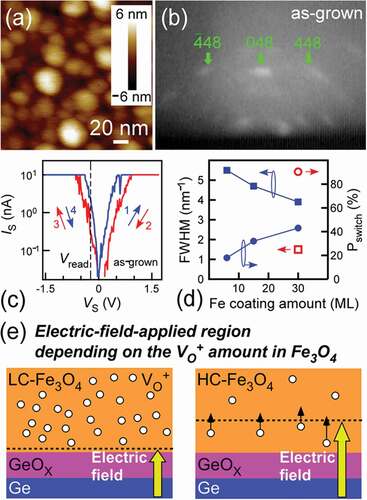
The resistive switching characteristics in as-grown NCs with Fe coating layers of 6, 15, and 30 MLs were measured using C-AFM. The VS was swept in the following order: (1) 0 V → 2 V, (2) 2 V → 0 V, (3) 0 V → −2 V, and (4) −2 V → 0 V. In each sample, the IS-VS curves were acquired 15–20 times on each NC and measured NC number was 6–8 for each sample (total IS-VS curves: 120 for each sample). ) is the IS-VS curve of as-grown NCs with Fe coating layer of 30 MLs. The NCs showed the bipolar-type resistive switching characteristics with high resistive state (HRS) and low resistive state (LRS). The resistive switching probability was estimated by defining as the switching observation number divided by measurement number (Supplemental Material 2). The average resistive switching probabilities in one sample (Pswitch) were ~18, ~32, and ~43% in Fe3O4 NCs on Ge nuclei with Fe coating layers of 6, 15, and 30 MLs, respectively ()). The Fe coating amount dependence of the crystallinity and the Pswitch demonstrated that Pswitch becomes higher as the crystallinity of Fe3O4 NCs is enhanced. In NCs with lower crystallinity, it can be considered that there are more defects (oxygen vacancies) in Fe3O4. The carrier concentration can be increased in Fe3O4 due to more oxygen vacancies, enhancing the screening effect of applied electric field in Fe3O4. As a result, the electric-field-induced oxygen vacancy movement becomes difficult to occur in Fe3O4, resulting in low Pswitch in defective samples ()). On the other hand, in NCs with higher crystallinity, the electric-field-induced oxygen vacancy movement likely occurs due to the small screening effect, resulting in higher Pswitch ()).
3.2. Composition and structural analyses of annealed NCs
To enhance the crystallinity of Fe3O4 NCs, as-grown NCs were post-annealed under an oxygen pressure of 2 × 10−4 Pa, where the two post-annealing temperatures were used: 250°C and 400°C. The analyses of 224Fe3O4 spots in RHEED patterns were performed by fitting with Gaussian function. The FWHM values of the 224Fe3O4 fitted peaks in the NCs annealed at 250°C and 400°C were 1.5 and 0.5 nm−1, respectively, indicating that the crystallinity of Fe3O4 was enhanced as post-annealing temperature became higher ()). The compositions of as-grown NCs and the NCs annealed at 250°C and 400°C were investigated by XPS measurements in the Fe2p region (Supplemental Material 3). Other studies have reported that FeO and γ-Fe2O3 have satellite peaks near 715 or 720 eV, respectively, while Fe3O4 has no satellite peaks [Citation30]. The XPS spectra of as-grown NCs and the NCs annealed at 250°C and 400°C displayed no satellite peaks, indicating that all the samples are Fe3O4. We also measured the XPS spectra in the Ge3d region to obtain the compositional information near the Fe3O4/Ge interface (Supplemental Material 3). All the NCs had the peaks coming from oxidation states of Ge, proving that GeOx was formed at the interface between Fe3O4 and Ge nuclei. In the sample post-annealed at higher temperature (NCs annealed at 400°C), remarkable Fe-Ge peaks were also observed. The XPS spectra in the Ge3d region were deconvolved with Gaussian function at the peak positions of Ge0 (29.3 eV), Ge+ (30.1 eV), Ge2+ (31.1 eV), Ge3+ (32.0 eV), Ge4+ (32.6 eV), and Fe-Ge (29.8 eV) [Citation31,Citation32]. The integrated intensity ratios of Fe-Ge peak to the sum of all the peaks (Fe-Ge mixing ratio) were almost zero for as-grown (~0.6%) and NCs annealed at 250°C (~0.3%), while the ratio was high (17.4%) for NCs annealed at 400°C ()). In NCs annealed at 400°C, this high Fe-Ge mixing ratio implies that Fe-Ge mixing occurred at the region near the interface, namely in GeOx interface layer, during high-temperature annealing process. This demonstrates that as-grown NCs and NCs annealed at 250°C without high-temperature annealing process have higher-quality GeOx with almost no Fe-Ge mixing than NCs annealed at 400°C.
Figure 3. (a) FWHM estimated from 224Fe3O4 peak in RHEED (left axis) and Fe-Ge mixing ratio measured from XPS spectra (right axis) in each sample (as-grown: as-grown NCs, 250: NCs annealed at 250°C, and 400: NCs annealed at 400°C). (b) Low-magnification HRTEM image of NCs annealed at 250°C. (c) Enlarged HRTEM image of the square region in (b). FFT patterns of (d) regions B and (e) A in (c). The region marked by the broken line denotes GeOx. Theoretical FFT patterns of (f) Fe3O4 and (g) Ge
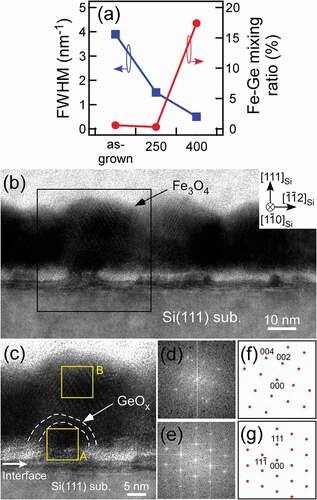
) shows a cross-sectional HRTEM image of NCs annealed at 250°C with high-crystallinity Fe3O4 and high-quality GeOx. It was confirmed that NCs with small size of ~30 nm were formed, which is consistent with the result of AFM observation. ) is an enlarged image of the square region in ). The crystal structures in the regions A and B in ) were analysed by fast Fourier transformation (FFT). As shown in ) and (e), the FFT patterns of regions B and A were consistent with the theoretical diffraction ones of Fe3O4 and Ge with the epitaxial relationship of (012)Fe3O4//(111)Ge () and (g)), respectively, demonstrating that Fe3O4 shell/Ge core NCs were epitaxially formed. In addition, the bright contrast region was observed between Fe3O4 shell and Ge core, as indicated by the arrow in the HRTEM image ()), implying that amorphous GeOx exists. Thus, HRTEM observations revealed the structures of NCs: Fe3O4/GeOx/Ge NCs.
3.3. Resistive switching characteristics in annealed NCs
In C-AFM measurements, bipolar-type resistive switching characteristics were observed in as-grown NCs ()) and NCs annealed at 250°C ()), while the resistive switching seldom occurred in NCs annealed at 400°C ()). By considering there is Fe-Ge mixing (low-quality GeOx) only in NCs annealed at 400°C, it was found that the unobserved resistive switching characteristics in NCs annealed at 400°C were attributed to the existence of FeGe alloys in GeOx although NCs annealed at 400°C have higher-crystallinity Fe3O4 than other NCs. To quantitatively investigate the nanostructure interface effect on the resistive switching characteristics, we measured Pswitch and Off/On ratio, where the IS-VS curves were acquired 15–20 times on each NC and measured NC number was 6–8 for each sample (total IS-VS curves: 120 for each sample). The Pswitch values were ~43, ~90, and ~3% in as-grown NCs, NCs annealed at 250°C and 400°C, respectively () and Supplemental Material 2). Note that NCs annealed at 250°C exhibited substantially higher Pswitch (~90%) than those of the other NCs. Besides, the standard deviation of the resistive switching probabilities of individual NCs in the NC sample annealed at 250°C (Supplemental Material 2) was 0.09, which was extremely smaller than those of as-grown NCs (0.26) and previous Fe3O4 NCs formed at high temperature (0.3). This indicates that the resistive switching uniformity was improved by forming high-crystallinity Fe3O4 and high-quality GeOx. The NCs annealed at 250°C exhibited higher Off/On ratio (~58) at a reading VS (Vread) of ~ −0.5 V than those of the other NCs: ~0 for NCs annealed at 400°C and ~9 for as-grown NCs ()). During the IS-VS measurement cycles, the HRS resistance gradually got larger, indicating that the NCs memorize the current history like memristor. From its higher Pswitch and Off/On ratio, the NCs annealed at 250°C are most suited for NC memory among them. Compared with as-grown NCs, high Pswitch and Off/On ratio in NCs annealed at 250°C can be attributed to the low concentration of oxygen vacancies; this relates to the higher Fe3O4 crystallinity, which can be explained by the same mechanism as for as-grown NCs ()). Another remarkable fact is that the formation of FeGe alloys in GeOx prevented the resistive switching ()). In the NCs with low-quality GeOx (including FeGe alloys), the electric field is not applied to GeOx because FeGe alloys in GeOx work as current leak paths. It should be noted that the resistive switching characteristics were affected by character of Fe3O4 and GeOx, implying that HRL related to resistive switching is composed of both GeOx and Fe3O4 near Fe3O4/GeOx interface. For further enhancement of resistive switching performance, almost perfect stoichiometric Fe3O4 and high-quality GeOx without current leak paths are key structures.
Figure 4. The IS-VS curves of (a) NCs annealed at 250°C and (b) at 400°C. (c) Pswitch and Off/On ratio of all the NCs. The solid squares and circles denote the Pswitch and the Off/On ratio, respectively. (d) Schematic of the GeOx quality effect on the resistive switching characteristics
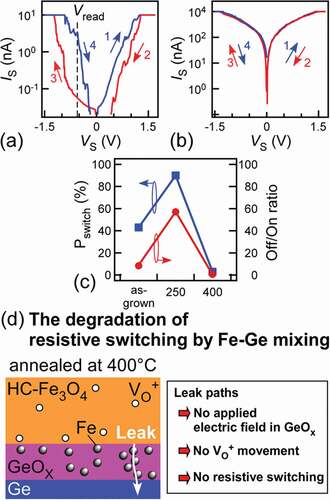
The resistive switching mechanism in this system can be discussed below. In the bipolar-type resistive switching, there are mainly two mechanisms such as filament- or interface-type. If the resistive switching mechanism in the Fe3O4 is filament-type, the resistive switching can be caused in Fe3O4 films without Ge. However, in our previous study, resistive switching was not observed in conventional pulse laser deposition Fe3O4 films on Si substrate without Ge [Citation17]. The quality of the pulse laser deposition films, which is related to some defects (oxygen vacancy concentration, point defect species), is similar to that of the present Fe3O4/Ge NCs because of the same growth condition of low oxygen pressure (10−4 Pa). Therefore, the filament-type mechanism is ruled out in the present system. On the other hand, in terms of the deficiency, the quality of pulse laser deposition films and the present Fe3O4/Ge NCs can be quite different from the reported films formed by sputtering method exhibiting resistive switching [Citation19,Citation20].
In the case of interface-type resistive switching, there are several candidates of resistive switching interface: Pt-Ir cantilever/Fe3O4, Fe3O4/GeOx, and GeOx/Ge. The C-AFM observations in air might cause the anodic oxidation of NC surface under Pt-Ir cantilever, bringing the resistance change when applying negative VS. In the same mechanism, Fe3O4 films without Ge must show resistive switching behavior. In our previous study, the pulse laser deposition Fe3O4 films without Ge did not occur. Therefore, the resistive switching by anodic oxidation is ruled out. Next, we discuss whether the resistive switching at the GeOx/Ge interface can be caused or not. In our previous study [Citation25], Ge nuclei covered with GeOx, namely the sample without Fe3O4, did not exhibit resistive switching, indicating that the GeOx/Ge is not a resistive switching interface in the present system. Therefore, the possible resistive switching interface is narrowed down to the Fe3O4/GeOx.
We consider the HRL, where the electric field is mainly applied when applying VS to NCs. For resistive switching, the electric field application to GeOx is required because the resistive switching did not occur when the electric field cannot be applied to GeOx due to the formation of FeGe alloys working as current leak paths. This indicates that GeOx is a part of HRL. In addition, the resistance of Fe3O4 should be relatively high because the resistive switching performance becomes higher with enhancing Fe3O4 crystallinity. This indicates that the electric field should also be applied to Fe3O4 near Fe3O4/GeOx interface. From these results, it is considered that HRL is composed of both GeOx and Fe3O4 near Fe3O4/GeOx interface. However, we believe that the main contribution of the HRL resistance comes from GeOx because resistive switching seldom occurred at zero electric field in GeOx in NCs annealed at 400°C.
As shown in , when applying VS to NCs, positively charged oxygen vacancies move in GeOx and Fe3O4 near Fe3O4/GeOx interface. When the x value of GeOx gets larger (smaller) by this ionic movement, the volume of the high resistance GeOx with large x becomes larger (smaller) [Citation33] and the HRL thickness composed of high resistance GeOx increases (decreases). On the other hand, as the effect of the electric field applied to Fe3O4 near Fe3O4/GeOx interface, two possibilities are considered: (1) changing resistance states of Fe oxide layer near Fe3O4/GeOx interface: LRS of Fe3O4 and HRS such as γ-Fe2O3 or FeGeOx by the ionic movement, (2) supplying oxygen vacancies or oxygens from Fe3O4 region to GeOx. By either function, the electric-field resistive change is enhanced. This deep comprehension about the resistive switching mechanism is presenting the material design guideline for improving various resistive switching characteristics.
3.4. Direct observation of memory effect
Here, the memory effect in NCs annealed at 250°C was directly observed by performing current mapping with C-AFM. ) and (b) show AFM and current mapping images, respectively, before applying the VS of +2 V. The current mapping images were observed at the Vread of −0.5 V, which applied voltage does not cause the resistive switching. White contrasts indicate the higher electric currents between cantilever and sample. Almost all NCs show white contrasts in current mapping images, which indicates that the initial states of NCs were LRS. We applied voltages to the samples by scanning the square region of ) at VS of +2 V to cause the resistive switching. After applying the VS, the white contrasts in the square region disappeared and most of the NC sites inside the square region became darker compared with other NCs outside the region () and (d)). Thus, it was directly observed that the resistance of NCs in the square region changed from LRS to HRS through the application of VS of +2 V. AFM and a current mapping image were observed at the Vread of −0.5 V () and (f)) when the time of 1800 s passed after the resistive switching by scanning at VS of +2 V. The results demonstrate that the contrast in square region was kept darker, indicating that the resistance in NCs has been memorized since the resistive switching (LRS to HRS). We also confirmed the resistance retention of more than 7200 s in such C-AFM method () and (h)). The direct observation of the memory effect in NCs demonstrates that NCs annealed at 250°C have a high potentiality as a non-volatile memory. Unlike the film memory material, the observation of the memory effect in ultrasmall NCs has never been reported in ReRAM. The experimental confirmation of the memory effect existence even in ultrasmall NCs is significant for realizing non-volatile NC memory leading to neuromorphic device.
Figure 6. Memory effect of NCs annealed at 250°C (a, c, e, g) AFM and (b, d, f, h) current mapping images of the NCs at the VS of −0.5V: (a, b) before applying VS of +2V, (c, d) just after applying VS of +2V, (e, f) 1800 s later since the resistive switching, and (g, h) 7200 s later since the resistive switching, respectively. The current mapping image when applying VS of +2V is shown in the inset
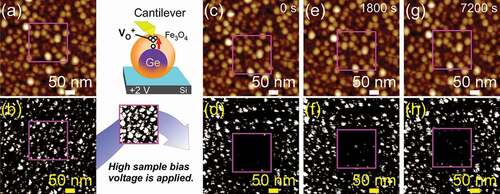
4. Conclusions
We developed high-density and isolated Fe3O4/GeOx/Ge NCs with high-performance resistive switching characteristics by low-temperature growth. Therein, the quality of the interfaces; the crystallinity of Fe3O4 and the quality of GeOx were successfully enhanced by annealing under proper condition: low oxygen pressure (2 × 10−4 Pa). The high quality of interfaces enables effective application of electric field to Fe3O4 and GeOx. Then, the electric field induces positively charged oxygen vacancy movement, leading to the oxidation degree change of HRL composed of Fe oxide and GeOx. As a result, the thickness of HRL can be changed by applying the electric field effectively. The NCs annealed at 250°C showed the bipolar resistive switching characteristics with higher Pswitch of ~90% and higher Off/On ratio of ~58. The memory effect in NCs annealed at 250°C was also observed by C-AFM method successfully. The experimental confirmation of the memory effect existence even in ultrasmall NCs is significant for realizing non-volatile NC memory leading to neuromorphic device.
Supplemental Material
Download PDF (782.8 KB)Disclosure statement
No potential conflict of interest was reported by the authors.
Supplemental material
Supplemental data for this article can be accessed here.
Additional information
Funding
References
- Han JS, Le. QV, Choi J, et al. Lead-free all-inorganic cesium tin iodide perovskite for filamentary and interface-type resistive switching toward environment-friendly and temperature-tolerant nonvolatile memories. ACS Appl Mater Interfaces. 2019;11(8):8155–8163.
- Yang JJ, Strukov DB, Stewart DR. Memristive devices for computing. Nat Nanotech. 2013;8(1):13–23.
- Shi Y, Liang X, Yuan B, et al. Electronic synapse made of layered two-dimensional materials. Nat Electron. 2018;1:458–465.
- Han UB, Lee JS. Bottom-up synthesis of ordered metal/oxide/metal nanodots on substrates for nanoscale resistive switching memory. Sci Rep. 2016;6(1):25537.
- Wang LG, Cao ZY, Qian X, et al. Atomic layer deposited oxide-based nanocomposite structures with embedded CoPtx nanocrystals for resistive random access memory applications. ACS Appl Mater Interfaces. 2017;9(7):6634–6643.
- Yang Y, Huang R. Probing memristive switching in nanoionics devices. Nat Electron. 2018;1:274–287.
- Nagashima K, Yanagida T, Oka K, et al. Resistive switching multistate nonvolatile memory effects in a single cobalt oxide nanowire. Nano Lett. 2010;10(4):1359–1363.
- Nagashima K, Yanagida T, Oka K, et al. Prominent thermodynamical interaction with surrounding on nanoscale memristive switching of metal oxides. Nano Lett. 2012;12(11):5684–5690.
- Hua Q, Wu H, Gao B, et al. A threshold switching selector based on highly ordered Ag nanodots for X-point memory applications. Adv Sci. 2019;6:1900024.
- Yoon JH, Han JH, Jung JS, et al. Highly improved uniformity in the resistive switching parameters of TiO2 thin films by inserting Ru nanodots. Adv Mater. 2013;25(14):1957–1992.
- Lee M-J, Lee CB, Lee D, et al. A fast, high-endurance and scalable non-volatile memory device made from asymmetric <sub>Ta2O5−x/TaO2−x bilayer structures. Nat Mater. 2011;10(8):625–630.
- Kwon D-H, Kim KM, Jang JH, et al. Atomic structure of conducting nanofilaments in TiO2 resistive switching memory. Nat Nanotechnol. 2010;5(2):148–153.
- Song SJ, Seok JY, Yoon JH, et al. Real-time identification of the evolution of conducting nano-filaments in TiO2 thin film ReRAM. Sci Rep. 2013;3(1):3443.
- Waser R, Aono M. Nanoionics-based resistive switching memories. Nat Mater. 2007;6(11):833–840.
- Sawa A. Resistive switching in transition metal oxides. Mater Today. 2008;11(6):28–36.
- Yu S, Guan X, Philip Wong H-S. Conduction mechanism of TiN/HfOx/Pt resistive switching memory: a trap-assisted-tunneling model. Appl Phys Lett. 2011;99(6):063507.
- Ishibe T, Matsui H, Watanabe K, et al. Epitaxial iron oxide nanocrystals with memory function grown on Si substrates. Appl Phys Express. 2016;9(5):055508.
- Ishibe T, Kurokawa T, Naruse N, et al. Resistive switching at the high quality metal/insulator interface in Fe3O4/SiO2/α-FeSi2/Si stacking structure. Appl Phys Lett. 2018;113(14):141601.
- Odagawa A, Katoh Y, Kanzawa Y, et al. Electroforming and resistance-switching mechanism in a magnetite thin film. Appl Phys Lett. 2007;91(13):133503.
- Muraoka S, Osano K, Kanazawa Y. et al. Fast switching and long retention Fe-O ReRAM and its switching mechanism. Tech Dig IEDM. 2007; 779–782.
- Nakamura Y, Murayama A, Watanabe R, et al. Self-organized formation and self-repair of a twodimensional nanoarray of Ge quantum dots epitaxially grown on ultrathin SiO2-covered Si substrates. Nanotechnology. 2010;21(9):095305.
- Nakamura Y, Watanabe K, Fukuzawa Y, et al. Observation of the quantum-confinement effect in individual Ge nanocrystals on oxidized Si substrates using scanning tunneling spectroscopy. Appl Phys Lett. 2005;87(13):133119.
- Nakamura Y, Isogawa M, Ueda T, et al. Anomalous reduction of thermal conductivity in coherent nanocrystal architecture for silicon thermoelectric material. Nano Energy. 2015;12:845–851.
- Yamasaka S, Nakamura Y, Ueda T, et al. Phonon transport control by nanoarchitecture including epitaxial Ge nanodots for Si-based thermoelectric materials. Sci Rep. 2015;5(1):14490.
- Nakamura Y. Nanostructure design for drastic reduction of thermal conductivity while preserving high electrical conductivity. Sci Technol Adv Mater. 2018;19(1):31–43.
- Matsui H, Ishibe T, Terada T, et al. Resistive switching characteristics of isolated core-shell iron oxide/germanium nanocrystals epitaxially grown on Si substrates. Appl Phys Lett. 2018;112(3):031601.
- Stanka B, Hebenstreit W, Diebold U, et al. Surface reconstruction of Fe3O4(001). Surf Sci. 2000;448(1):49–63.
- Huang Z, Chen Q, Zhai Y, et al. Oxygen vacancy induced magnetization switching in Fe3O4 epitaxial ultrathin films on GaAs(100). Appl Phys Lett. 2015;106(18):182401.
- Ishibe T, Watanabe K, Nakamura Y. Effect of Fe coating of nucleation sites on epitaxial growth of Fe oxide nanocrystals on Si substrates. Jpn J Appl Phys. 2016;55(8S1):08NB12.
- Ruby C, Humbert B, Fusy J. Surface and interface properties of epitaxial iron oxide thin films deposited on MgO(001) studied by XPS and Raman spectroscopy. Surf Interface Anal. 2000;29:377–380.
- Schmeisser D, Schnell RD, Bogen A, et al. Surface oxidation states of germanium. Surf Sci. 1986;172(2):455–465.
- Venugopal R, Sundaravel B, Wilson IH, et al. Structural and magnetic properties of Fe-Ge layer produced by Fe ion-implantation into germanium. J Appl Phys. 2002;91(3):1410–1416.
- Prakash A, Maikap S, Rahaman SZ, et al. Resistive switching memory characteristics of G/GeOx nanowires and evidence of oxygen ion migration. Nanoscale Res Lett. 2008;8:220.

